In today’s busy homes, choosing a dog that fits well with family life, particularly with children, is crucial. Dachshunds, recognized for their unique looks and energetic nature, are a favored option. This guide examines the question, ‘Are dachshunds good with kids?‘ focusing on their characteristics, possible challenges, and important factors to consider.
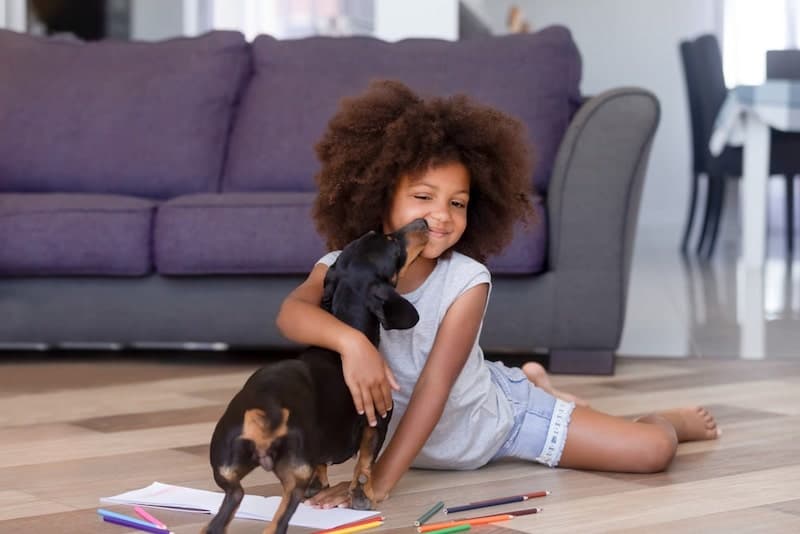
Are dachshunds good with kids? Reasons This Breed as Your Family Pet
Playful and energetic nature
Dachshunds have a lively nature that appeals to children, making them fun companions for play.
Loyalty and affection towards family members
Dachshunds are recognized for their loyalty and frequently develop deep connections with their human family members, including kids.
Watch Over Children
They Protect Children Dachshunds often act like guard dogs and can be very protective of their owners. They remain alert to potential dangers that could threaten their loved ones. This trait might cause them to bark at people approaching your home or at strangers they encounter during walks. Dachshunds love being part of a group and will consider your family as their new pack, taking on the responsibility of protecting all its members.
Love to Play
They Love to Play Dachshunds are often energetic and playful. It’s essential for their overall well-being and happiness to get enough exercise each day. When this breed has ample physical activity, it helps prevent them from misbehaving and keeps them at a healthy weight. Teaching your child how to safely interact with your dog can help ensure they get the necessary exercise. This also enhances the connection between your child and the dog. Furthermore, you might consider setting up a daily family walk so that everyone can enjoy important exercise together.
They are Adventurous
In conclusion, dachshunds are quite adventurous. They enjoy venturing out and discovering new locations with their families. This quality makes them a great companion for family trips, whether it’s camping, hiking, or swimming.
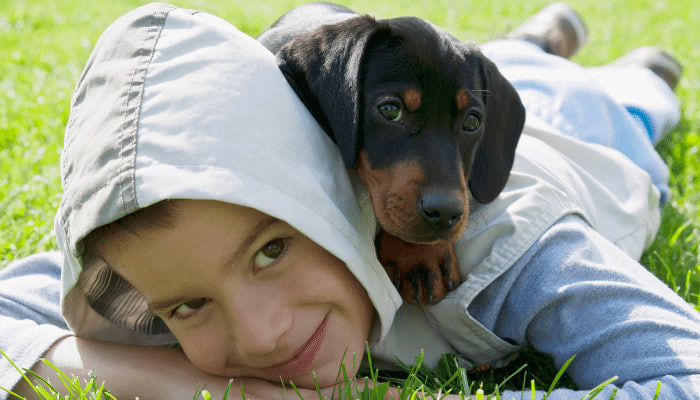
Potential Dachshund Challenges with Children
Sensitive to Rough Handling
Dachshunds are small and have elongated bodies, making them especially susceptible to being handled roughly. Young children, driven by their natural curiosity and playfulness, might inadvertently treat them harshly. This can result in stress and discomfort for the Dachshund, which may lead to fear or defensive reactions. It’s important to educate children on how to interact with Dachshunds gently and respectfully to prevent causing them distress.
Stubbornness and Difficulty in Training
Dachshunds are recognized for their independent and occasionally obstinate temperament. This can pose difficulties in training, particularly for inexperienced owners or families with young kids who might not consistently uphold rules and commands. Dachshunds may push limits and defy instructions, necessitating patience, positive reinforcement, and steady training techniques. For families with children, it’s crucial to include them in training sessions with adult supervision to help them learn how to interact properly with the dog and encourage good behaviors.
Back Problems and Risk of Injury
Dachshunds are susceptible to a condition known as Intervertebral Disc Disease (IVDD) because of their distinctive body structure, characterized by a long spine and short legs. IVDD can lead to painful spinal issues and even paralysis if the discs become herniated or burst. Activities that put strain on the back, like jumping on and off furniture or being handled roughly, can heighten the risk of injury. Children might unknowingly engage in actions that stress the Dachshund’s back, so it’s essential to teach them about the importance of gentle handling and to supervise their interactions to avoid accidents.
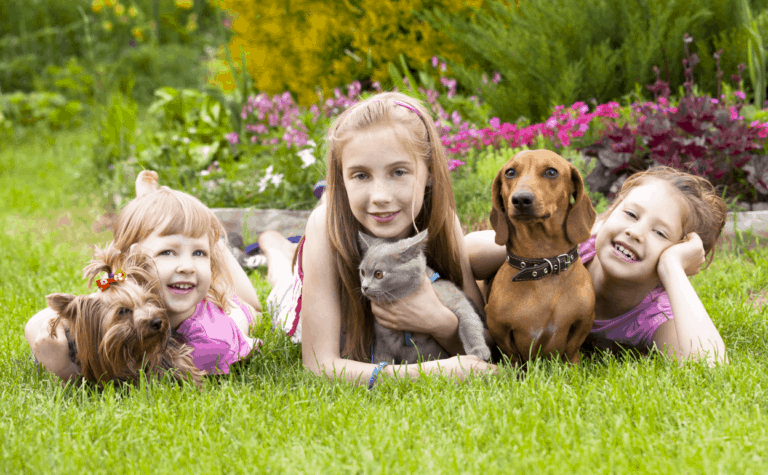
Consider age
Dachshunds with Babies and Toddlers:
Increased Vigilance Required: Dachshunds are delicate dogs, and their elongated bodies make them especially prone to injuries from rough treatment or falls. Young children may not grasp the importance of gentle interactions with pets, potentially causing unintentional harm to the Dachshund. Thus, it’s essential for parents to closely monitor all interactions and educate young kids on how to handle the dog with kindness and consideration. Additionally, it’s wise to establish safe areas where the Dachshund can go if they feel stressed or need some time away from socializing.
Dachshunds with School-Age Children:
Active Play and Friendship: Children in the school-age range (generally between 6 to 12 years old) often form close relationships with Dachshunds. At this age, they are typically better at grasping and adhering to guidelines for gentle interaction and suitable play. Although small, Dachshunds love engaging in lively activities such as fetch or brief walks. This age group can participate in organized play with the dog, which not only offers physical activity for the Dachshund but also nurtures a sense of companionship and responsibility in the child.
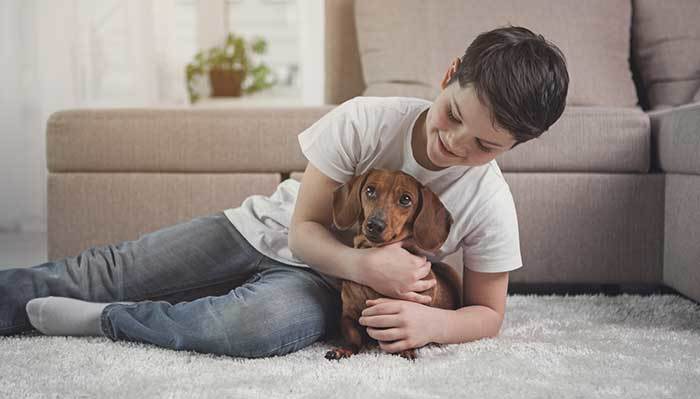
Dachshunds with Teenagers:
Valuable Companionship: Teenagers (ages 13 and older) can develop strong bonds with Dachshunds, valuing their loyalty and loving demeanor. At this stage, effective training and comprehension are essential, as teens can engage in the dog’s care, training, and exercise activities. Dachshunds can be excellent companions for teenagers, providing emotional support and friendship during this pivotal time in their lives. Additionally, looking after a pet can impart crucial life skills to teenagers, including responsibility, empathy, and patience.
Training Dachshund dogs to be good with children
Teaching Dachshunds to interact appropriately with children is crucial for ensuring a safe and positive bond between the dog and young family members. Below are comprehensive steps and factors to consider for successfully training Dachshunds to be child-friendly:
1. Early Socialization:
- Introducing to Children: Expose your Dachshund to children early on in controlled environments. This helps the dog get used to the way children move, sound, and behave.
- Encouraging Positive Interactions: Make sure that all encounters with children are positive experiences. Reward calm and gentle actions from both the Dachshund and the kids with treats, praise, and playtime.
- Monitoring Interactions: Always keep an eye on the interactions between your Dachshund and children, especially at first. This allows you to step in if needed and ensures that the experiences are safe and enjoyable for everyone involved.
2. Basic Obedience Training:
- Sit, Stay, and Come: Train your Dachshund in fundamental obedience commands like sit, stay, and come. These commands are crucial for managing interactions with kids and regulating the dog’s behavior in different scenarios.
- Positive Reinforcement: Employ positive reinforcement methods such as treats, praise, and toys to encourage and reward your Dachshund for following commands. Consistency and patience are essential for effective training.
3. Gentle Handling Training:
- Promote Gentle Interaction: Instruct both children and adults on how to engage gently with the Dachshund. Demonstrate the correct methods for petting, approaching, and playing with the dog to prevent unintentional scares or injuries.
- Body Handling: Familiarize your Dachshund with being touched all over its body, including its paws, ears, and tail. This prepares them for situations where children may accidentally touch them in various ways.
4. Creating a Safe Environment:
- Secure Areas: Create safe zones for your Dachshund to retreat to when they feel stressed or need a break from being around children.
- No-Child Zones: Designate specific areas in your home where the Dachshund can unwind without being disturbed by children, providing them with a peaceful spot to escape to when necessary.
5. Consistent Rules and Boundaries:
- Consistency: Set clear and uniform rules and limits for both the Dachshund and the children. For instance, instruct the kids not to interrupt the dog during meals or nap time and to honor the dog’s personal space.
- Family Involvement: Engage the whole family in the training process and in establishing boundaries. Maintaining consistent expectations and reactions to behaviors strengthens positive interactions between the Dachshund and the children.
6. Monitoring and Adjustment:
- Observe Interactions: Keep a close eye on the interactions between your Dachshund and children, particularly as the kids grow and their behaviors evolve. Be prepared to modify your training and supervision strategies to align with their developmental changes.
- Seek Professional Guidance: If you face difficulties in teaching your Dachshund to interact well with children, consider consulting a professional dog trainer or behaviorist who specializes in both Dachshunds and child-dog dynamics.
By adhering to these comprehensive steps and considerations, you can successfully train your Dachshund to behave suitably around children, fostering a safe and positive relationship between your pet and family members. Consistency, patience, and positive reinforcement are essential for creating a harmonious environment where both children and Dachshunds can flourish together.
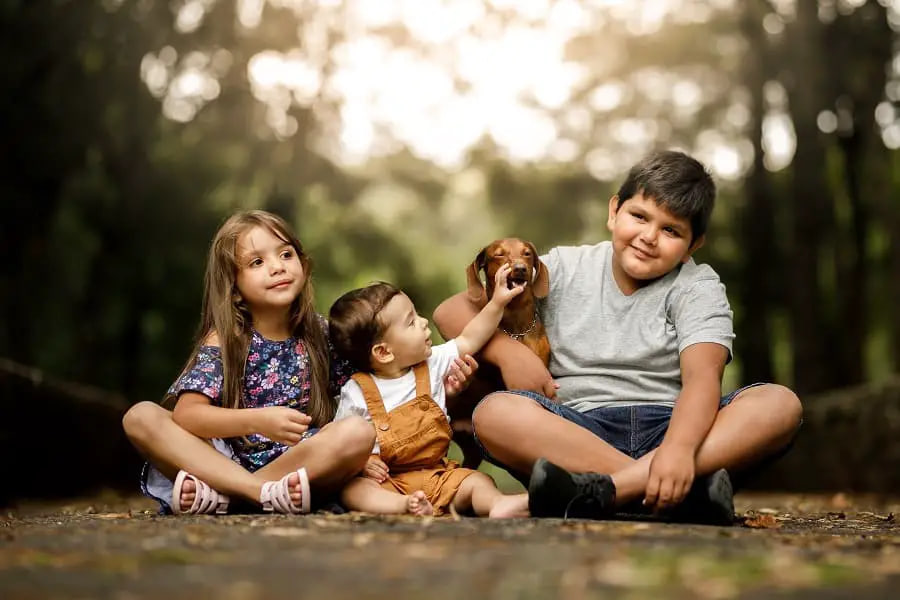
Decision making
- Evaluate your family’s way of life and requirements: Think about whether a dachshund’s personality and care needs fit well with your family’s lifestyle and interactions.
- Consider adopting or purchasing a dachshund: Look into adoption options or trustworthy breeders when getting a dachshund, focusing on their health and behavior.
- Get your home and family ready for a new dog: Make sure your living space is secure and inviting for a dachshund, helping them adjust easily to family routines.
FAQs
Q : How does the shedding of Dachshund dogs affect their suitability as pets for families with children?
A: Many individuals are curious about whether Dachshund dogs shed. The answer to ‘do Dachshund dogs shed?‘ can differ based on the type of coat they have-smooth, long, or wire-haired. Typically, smooth-coated Dachshunds shed moderately, whereas long-haired and wire-haired ones may shed more. Consistent grooming and brushing can help control shedding, making them a good choice for families with children who might have allergies or prefer less fur in their home. When selecting a Dachshund for a household with kids, it’s essential to consider both grooming requirements and temperament.
Q : How do Dachshunds typically interact with both children and cats in a household, and what factors contribute to their compatibility with both?
A: Many people considering adopting a dachshund wonder, ‘Are dachshunds good with cats?‘ The interactions of dachshunds with children and cats can differ significantly. Typically, their temperament and early socialization are crucial factors. Some dachshunds may coexist peacefully with both children and cats, while others might need careful introductions and supervision to build positive relationships. Recognizing their unique personalities and behaviors can aid in assessing compatibility in a household with multiple pets.
Q : What are some signs that a Dachshund might not be comfortable around children, and how should that be addressed?
A Dachshund may show signs of discomfort around children through behaviors such as growling, snapping, avoiding interaction, displaying stiff body language, having ears pinned back, or a tucked tail. To address this, use positive exposure techniques, reward-based training, supervise interactions, teach children to respect the dog’s boundaries, and seek professional help if necessary.
Summary
In conclusion, the question ‘Are dachshunds good with kids?‘ generally gets a positive answer due to their energetic and loyal temperament. While individual personalities may vary, dachshunds tend to thrive in family settings where they receive proper training and socialization. By fostering a safe and nurturing environment, these dogs can form strong bonds with kids, which is why they are frequently regarded as child-friendly in many households.

